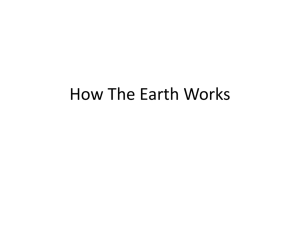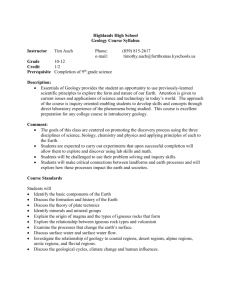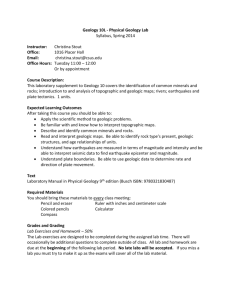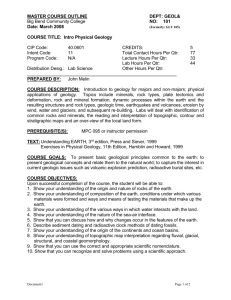Outline 1
advertisement
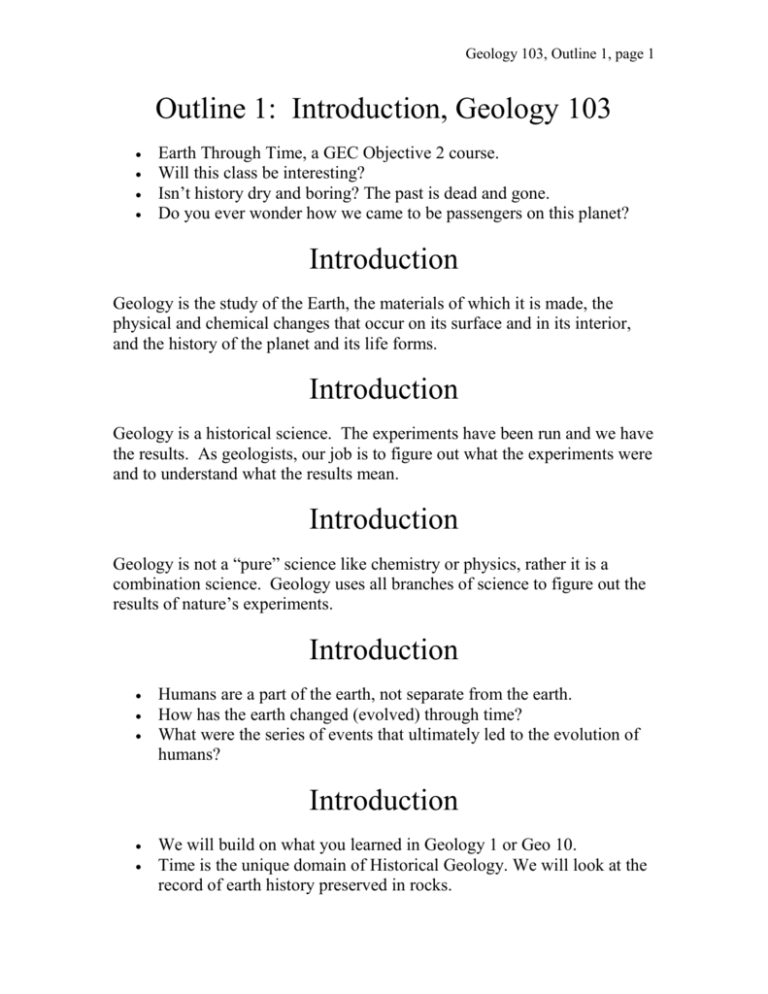
Geology 103, Outline 1, page 1 Outline 1: Introduction, Geology 103 Earth Through Time, a GEC Objective 2 course. Will this class be interesting? Isn’t history dry and boring? The past is dead and gone. Do you ever wonder how we came to be passengers on this planet? Introduction Geology is the study of the Earth, the materials of which it is made, the physical and chemical changes that occur on its surface and in its interior, and the history of the planet and its life forms. Introduction Geology is a historical science. The experiments have been run and we have the results. As geologists, our job is to figure out what the experiments were and to understand what the results mean. Introduction Geology is not a “pure” science like chemistry or physics, rather it is a combination science. Geology uses all branches of science to figure out the results of nature’s experiments. Introduction Humans are a part of the earth, not separate from the earth. How has the earth changed (evolved) through time? What were the series of events that ultimately led to the evolution of humans? Introduction We will build on what you learned in Geology 1 or Geo 10. Time is the unique domain of Historical Geology. We will look at the record of earth history preserved in rocks. Geology 103, Outline 1, page 2 How can we tell time? Radiometric dating Applies mostly to igneous rocks. How old are the oldest rocks? Sedimentary rocks associated with igneous rocks can be dated. How can we tell time? Age dating with fossils Allows the correct ordering of events in earth history. This is called relative dating. Evolutionary change works in only one direction. Fossil ages can be calibrated using radiometric dating. What is Evolution? Physical Evolution - changes in the physical world over geologic time. Organic Evolution - changes in life on earth over geologic time. Physical Evolution Unpredictable, but not undecipherable Produced by a series of random events Tied to organic evolution. e.g. Origin of oxygenated atmosphere Origin of iron deposits Origin of soils Organic Evolution Unpredictable, but not undecipherable Produced by a series of random events Tied to physical evolution. e.g. Origin of oxygenated atmosphere required for multicellular life Origin of soils required for advanced plants with roots Geology 103, Outline 1, page 3 How old is the earth? British physicist Lord Kelvin in the late 1800s studied the rate of heat loss from the earth’s interior. Concluded that the earth was about 30 M.Y. old. His methods were precise and dead wrong at the same time. How old is the earth? Why was Kelvin wrong? He didn’t know that heat was continually generated in the earth by radioactivity. Thus, the cooling rate of the earth did not measure the age of the earth. How old is the earth? Marie and Pierre Curie discovered radioactivity in 1889. Antoine Henri Bequerel discovered radioactive decay of uranium in 1895. This method indicates the earth is 4.6 B.Y. old. RECOGNITION OF "DEEP" TIME The mind seemed to grow giddy by looking so far into the abyss of time. John Playfair, 1805 METAPHORS FOR GEOLOGIC TIME The Geologic "Mile": approximately one foot per million years. The Geologic "Year": Homo habilis (1.8 M.Y) appears about 8 p.m. on Dec. 31, the last 5/100 of 1% of earth history. Australopithecus ramidus (4.4 M.Y.) appears about 4 p.m. on Dec. 31, the last 1/10 of 1% of earth history. Geologic Time Compressed into One Year: Geology 103, Outline 1, page 4 The earth is 4.6 BY old, therefore: 1 day = 12,300,000 years 1 hour = 513,000 years 1 minute = 8,550 years 1 second = 142 years Geologic Time Compressed into One Year 3.5 BY, first fossils, 81 days, March 22 2.5 BY, large continents, 162 days, June 11 600 MY, first animals, 316 days, Nov. 12 540 MY, first trilobites, 321 days, Nov. 17 480 MY, primitive fish, 326 days, Nov. 28 Geologic Time Compressed into One Year 344 MY, Appalachians forming, 337 days, Dec. 3 270 MY, Appalachians finished, 343 days, Dec. 9 221 MY, start of dinosaurs, 347 days, Dec. 13 65 MY, extinction of dinosaurs, 360 days, Dec. 26 Geologic Time Compressed into One Year 4.5 MY, earliest hominids, 365 days, Dec. 31, 4 p.m. Homo habilis (1.8 M.Y) appears about 8 p.m. on Dec. 31, the last 5/100 of 1% of earth history. Homo sapiens (0.1 M.Y.) appears just before the 10 minute warning on Times Square The Money Metaphor: "How much is one million?" It would take you approximately 3 years (2.74 yrs.) to spend $1 million at $1000/day. Geology 103, Outline 1, page 5 The Money Metaphor $1 million = 3 years $10 million = 30 years $100 million = 300 years $1 billion = 3000 years $4.5 billion = 13,500 years Rates of Seafloor Spreading. Slow events become rapid on a geologic time scale. The Atlantic Ocean is spreading at about 3 cm. per year, or about the rate of fingernail growth. Rates of Seafloor Spreading 1 year = 3 cm 10 years = 30 cm 100 years = 3 m 1000 years = 30 m 10,000 years = 300 m 100,000 years = 3 km Rates of Seafloor Spreading 1 million years = 30 km 10 MY = 300 km 100 MY = 3000 km 200 MY = 6000 km 225 MY = 6643 km (4118 miles) (5% of earth history) One Final Metaphor • 32 million seconds in a year. • If one second were to equal one year, then it would take 144 years to encompass all of geologic time.

